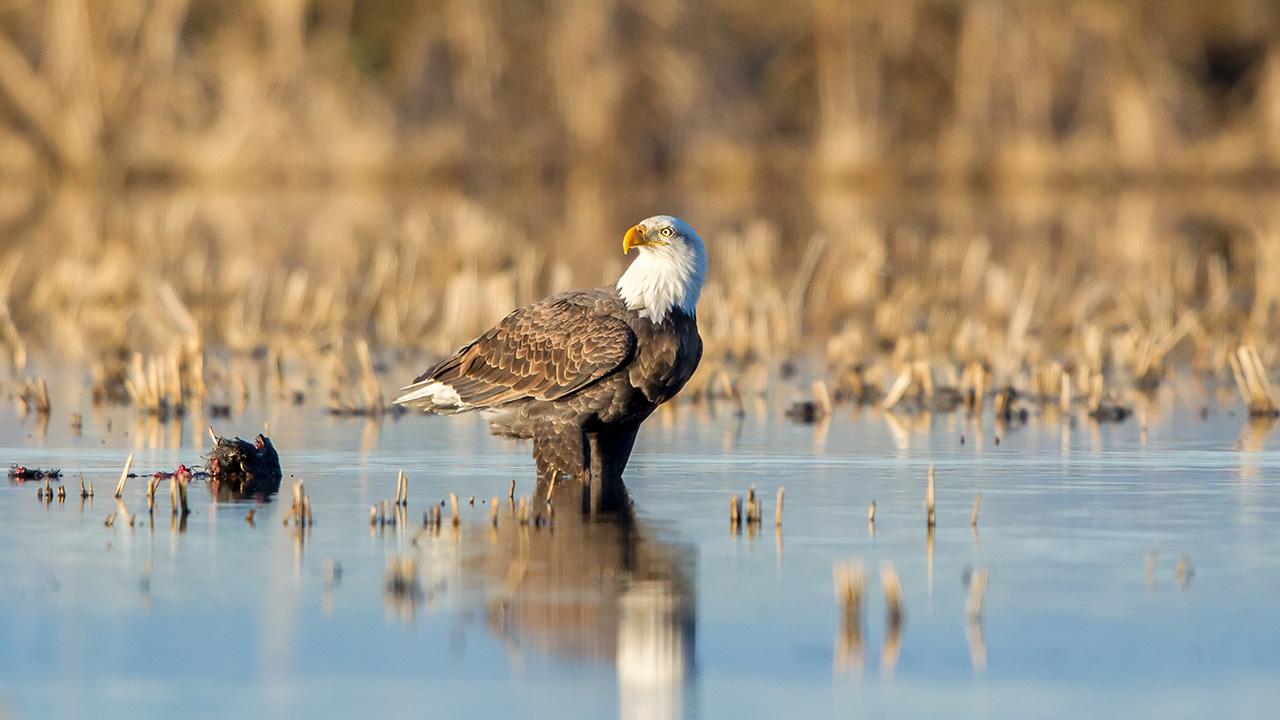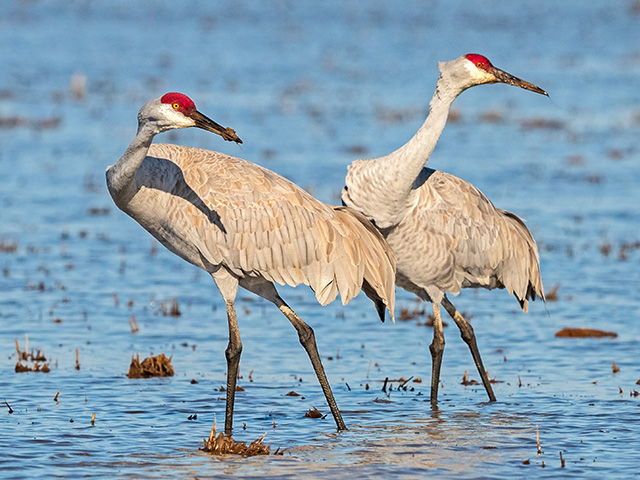
California rice fields provide vital habitat for birds, fish, snakes
Linquist contributes to report on acreage needed for wildlife conservation
Quick Summary
- There is room for rice farmers and conservationists to find common ground and work together in the effort to preserve ricelands for both wildlife and food production.

Will California’s rice acreage be enough to meet the needs of key species that thrive in the crop’s seasonally flooded fields? If not, how much acreage is needed? What management practices offer the greatest benefit, while also ensuring a good living for farmers?
This week, a report exploring these questions and offering a mosaic of answers is the topic of meetings that are starting with state policymakers and legislators. Bruce Linquist, a professor of Cooperative Extension in the UC Davis Department of Plant Sciences, contributed to the report by representing agriculture’s role and needs in the complex equation balancing the environment, food production and economics.
The report, A Conservation Footprint for California Rice, was funded primarily by the California Rice Commission in a grant to UC Davis and was released in February. The report’s big take-away: There is room for compatibility and working together.
California is the nation’s No. 2 rice producer. Grown primarily in the Central Valley, rice brought a gross value of $848 million in 2022, according to the state Department of Food and Agriculture. But the crop faces uncertainties around markets, water and climate. In response, some growers are fallowing fields, changing their management practices or switching to other crops.
Linquist worked with a team that included an economist and wildlife biologists eager to support acreage devoted to rice and to protect the needs of key varieties of birds, fish and snakes found in those acres. Each species benefits in different ways from the yearly flooding of rice fields, drainage for planting and postharvest management. But those needs often don’t match up, and they don’t always coincide with the needs of rice farmers.
“My primary contribution was quantifying the conversion of rice fields to other crops, both field crops and orchards, and how this may impact rice acreage.” Linquist said. He also offered understanding of how proposed wildlife habitat practices may impact rice production, both negatively and positively. “It was good for the team to have someone who works with farmers, and understands some of the agronomic constraints around proposed practices for wildlife….
”It’s a matter of trying to work with the variables of what’s optimal for each species and how that fits with what farmers are doing,” Linquist added.
Since the report’s release, members of the California Rice Commission have met with environmental organizations to discuss its findings. “The response there has been extraordinarily positive,” said Tim Johnson, commission president and CEO. This week, the commission’s team begins meetings with state agencies, including the Department of Natural Resources, and in May will start meetings with people in the state Legislature, he added.

Acreage to meet conservation goals: 500,000 acres
The authors' review focused on the needs of wintering ducks, wintering and breeding shorebirds, black terns, sandhill cranes, native fish and giant garter snakes. They developed a mapping framework of the species’ habitat, and an estimate of the rice acreage, management practices and priority locations for rice that would most greatly benefit each wildlife group.

“This was a highly interdisciplinary effort that I don’t think has been attempted at this scale for California rice or perhaps any other California agricultural crop working with wildlife,” said report co-lead John Eadie, a UC Davis professor emeritus in the Department of Wildlife, Fish and Conservation Biology who coordinated the 173-page effort among 13 authors. “I think this report provides the baseline for future work to come.”
Over the past decade, rice acreage has ranged from 250,000 to 540,000 acres in California; by late 2024, 478,000 acres of rice had been planted, according to the UC Rice Blog . The report found that approximately 470,000 to 500,000 acres defines the desired conservation footprint of rice for the most species of concern. The needs for the key species include:
- 30,000 acres for native fish
- 43,000 acres for sandhill cranes
- 80,000 acres for giant garter snakes
- 373,500 acres of winter-flooded rice and flooded fallow rice fields for non-breeding shorebirds
- 473,000 acres of planted rice to restore populations of black terns and help support breeding shore birds
- 500,000 acres for wintering ducks
Winter flooding critical
The authors emphasize that rice acreage alone — even as much as 500,000 acres — will not sustain these creatures unless water is available during the winter and during critical periods in the fall and spring. Winter flooding of the rice fields is especially critical for many of these species.
Historically, seasonal wetlands shaped the Central Valley’s ecology and biodiversity. Beginning in the mid-1800s, these lands were largely drained for agriculture, flood control and development.
“In the absence of natural wetlands, rice has become essential surrogate habitat for an incredible diversity of California wildlife,” said report co-editor Daniel Karp, a UC Davis professor in the Department of Wildlife, Fish and Conservation Biology. “In the face of climate-induced droughts and escalating water prices, providing rice farmers with the support needed to continue flooding their fields in winter is absolutely essential to safeguard this incredible conservation success story.”

Priority locations and management solutions
For nearly all wildlife groups, the Colusa and Sutter basins rank as the highest priority locations for rice habitat, given their proximity to wetlands and wildlife refuges. The Yolo Basin, Consumnes-Mokelumne Rivers region, and parts of the Delta are especially important for shorebirds and sandhill cranes. The Yolo and Sutter bypasses also represent critical areas for fish in flooded rice fields.
The conservation value of these areas, however, largely depends upon how they’re managed. In addition to winter flooding and water availability, spatial location, managing vegetation, irrigation canals and handling of post-harvest rice straw are just some of the considerations when managing rice for wildlife. The report outlines several strategies for each group.
“This kind of interdisciplinary work is challenging but so important to effective conservation,” said report co-author Kristen Dybala, a principal ecologist at Point Blue Conservation Science. “When we work together, we can identify opportunities for the same acres to contribute to multiple goals at once.”
While the report focused on key species, many more critters use ricelands for part or all of their life cycles. Nearly 230 varieties of birds, mammals, fish, amphibians and reptiles call the area home at least part of each year, according to the rice commission.
The value of rice

In addition to providing habitat for wildlife, rice production creates about $1 billion of added economic value and up to 7,500 jobs for California’s Sacramento Valley.
“For decades now, our growers have seen firsthand how much their rice fields are used by wildlife all throughout the year,” said Johnson, of the California Rice Commission. “This report by UC Davis details how these same fields that grow America’s sushi rice serve as the economic driver for our small communities and are also vital to our ecosystem in helping waterfowl, shorebirds, reptiles and fish thrive.”
The report was funded through a grant to the UC Davis Center for Watershed Sciences and to Point Blue Conservation Science.
Additional authors on the report include Francisco Bellido-Leiva, Lee Burrows, Sean Fogenburg, Andrew Rypel and Brian Todd of the UC Davis Department of Wildlife, Fish and Conservation Biology; Robert Walsh of Point Blue Conservation Science; and Daniel Sumner and Jessica Xu from UC Davis Agricultural and Resource Economics.
Media Resources
Legislation has been introduced into the California Legislature to designate the giant garter snake as the state snake. A Sacramento-area group has partnered with the California Rice Commission to support the initiative.
An earlier version of this story by Kat Kerlin may be read here.
- John Eadie, UC Davis Wildlife, Fish and Conservation Biology, jmeadie@ucdavis.edu
- Kat Kerlin, UC Davis News and Media Relations, 530-750-9195, kekerlin@ucdavis.edu
- Katie Cahill, California Rice Commission, kcahill@calrice.org
- Trina Kleist, UC Davis Department of Plant Sciences, tkleist@ucdavis.edu, (530) 754-6148 or (530) 601-6846
